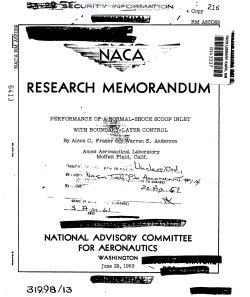naca-rm-a53d29
- Version
- 37 Downloads
- 1.16 MB File Size
- 1 File Count
- August 13, 2017 Create Date
- August 13, 2017 Last Updated
National Advisory Committee for Aeronautics, Research Memorandum - Performance of a Normal Shock Scoop Inlet with Boundary Layer Control

Tests were made on a normal—shock inlet mounted as a scoop on a flat
plate on which a turbulent boundary layer was generated. A boundary-
layer-removal scoop was provided between the inlet and the plate and
various amounts of the boundary layer were removed. The effect of
partial boundary-layer admittance to the main inlet on the total-pressure
recovery and flow stability was determined over a range of free-stream
Mach numbers from 1.35 to 1.75 and a range of scoop mass-flow ratios from
maximum to the least for which stable flow could be maintained.
Results of the tests indicated that the inlet flow stability was
unsatisfactory when the boundary-layer scoop was located in the entrance
plane of the main inlet; the stability was markedly improved when the
boundary—layer scoop was extended upstream. The total-pressure recovery
of the main inlet increased with boundary—layer removal for all Mach
numbers. Thrust calculations, which included calculated cowl, additive,
and boundary-layer-removal drags, indicated an optimum boundary-layer
removal of approximately 70 percent of the total boundary-layer thickness
for all mass-flow ratios and inlet Mach numbers tested. Comparison of
the thrust of the scoop inlet with the thrust that would be available if
normal-shock pressure recovery and no boundary-layer-removal drag had
been realized indicated that the scoop system can develop from 96 to 100
percent of this idealized thrust when optimum boundary-layer removal is
used.
In the design of jet—propelled aircraft it is often desirable to
locate the air inlets aft along the fuselage. Such inlet locations
involve the problem of fuselage boundary layer and its influence on the
inlet performance. In general, the admittance of this boundary layer
into a normal-shock scoop—type inlet results in a reduction in the dif—
fuser flow stability at reduced mass—flow ratios and also in a loss in
the total-pressure recovery. For supersonic inlet velocities these
adverse effects are increased due to shock—wave boundary-layer inter-
actions. The inlet characteristics can be improved if the boundary layer
ahead of the inlet is removed. However, boundary-layer removal causes
drag, the magnitude of which must be compared with the increase in thrust
resulting from the mnproved pressure recovery. Such an evaluation
requires knowledge of the relationship between the removal drag and the
thrust obtained by use of the main inlet with boundary—layer removal.
| File | Action |
|---|---|
| naca-rm-a53d29 Performance of a Normal Shock Scoop Inlet with Boundary Layer Control.pdf | Download |
Comment On This Post